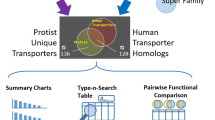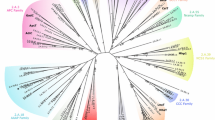Abstract
Purpose. To study the structure and function of the intestinal H+/ peptide transporter PET1, we compared its amino acid sequence with those of related transporters belonging to the oligopeptide transporter family PTR, and with more distant transporter families.
Methods. We have developed a new approach to the sequence analysis of proteins with multiple transmembrane domains (TMDs) which takes into account the repeated TMD-loop topology. In addition to conventional analyses of the entire sequence, each TMD and its adjacent loop residues (=TMD segments) were analyzed separately as independent structural units. In combination with hydropathy analysis, this approach reveals any changes in the order of the TMD segments in the primary structure and permits TMD alignments among divergent structures even if rearrangements of the order of TMD segments have occurred in the course of evolution.
Results. Alignments of TMD segments indicate that the TMD order in PTR transporters may have changed in the process of evolution. Consideration of such changes permits the alignment of homologous TMD segments from PTR transporters belonging to distant akaryotic and eukaryotic phyla. Multiple alignments of TMDs reveal several highly conserved regions that may play a role in transporter function. In comparing the PTR transporters with other transporter gene families, alignment scores using the entire primary structure are too low to support a finding of probable homology. However, statistically significant alignments were observed among individual TMD segments if one disregards the order in which they occur in the primary structure.
Conclusions. Our results support the hypothesis that the PTR transporters may have evolved by rearrangement, duplication, or insertions and deletions of TMD segments as independent modules. This modular structure suggests new alignment strategies for determining functional domains and testing relationships among distant transporter families.
Similar content being viewed by others
REFERENCES
G. L. Amidon and H. J. Lee. Annu. Rev. Pharmacol. Toxicol. 34:321–341 (1994).
W. Kramer, F. Girbig, U. Gutjahr, H.-W. Kleemann, I. Leipe, H. Urbach, and A. Wagner. Biochim. et Biophys. Acta 1027:25–30 (1990).
A. H. Dantzig, and L. Bergin. Biochim. et Biophys. Acta 1027:211–217 (1990).
S.-I. Matsumoto, H. Saito, and K.-I. Inui. J. Pharmacol. Exp. Ther. 270:498–504 (1994).
Y. J. Fei, Y. Kanal, S. Nussberger, V. Ganapathy, F. H. Leibach, M. F. Romero, S. K. Singh, W. F. Boron, and M. A. Hediger. Nature 368:563–566 (1994).
R. Liang, Y.-J. Fei, P. D. Prasad, S. Ramamoorthy, H. Han, T. L. Yang-Feng, M. A. Hediger, V. Ganapathy, and F. H. Leibach. J. Biol. Chem. 240:6456–6463 (1995).
M. Boll, D. Markovich, W.-M. Weber, H. Korte, H. Daniel, and H. Murer. Eur. J. Physiol. 429:146–149 (1994).
M. Boll, M. Herget, W. M. Weber, D. Markovich, J. Biber, W. Clauss, H. Murer, and H. Daniel. Proc. Natl. Acad. Sci. USA 93:294–289 (1996).
U. Wenzel, I. Gevert, H. Weintraut, W.-M. Weber, W. Claub, and H. Daniel. J. Pharmacol. Exp. Ther. 277:831–839 (1996).
K.-M. Yu-Covitz, G. L. Amidon, and W. Sadée. Pharm. Res. 13:1631–1634 (1996).
H.-Y. Steiner, F. Naider, and J. M. Becker. Mol. Microbiol. 16:825–834 (1995).
I. T. Paulsen, and R. A. Skurray. Trends Biochem. Sci. 19:404 (1994).
W. Sadée, V. Drübbisch, and G. L. Amidon. Pharm. Res. 12:1823–1837 (1995).
P. J. F. Henderson. Curr. Opin. Cell Biol 5:708–721 (1993).
A. Hagting, E. R. S. Kunji, K. J. Leenhouts, B. Poolman, and W. N. Konings. J. Biol. Chem. 269:11391–11399 (1994).
S. F. Altschul, W. Gish, W. Miller, E. W. Myers, and D. J. Lipman. J. Mol. Biol. 21:403–410 (1990).
R. F. Smith, and T. F. Smith. Prot. Engin. 5:35–41 (1992).
S. F. Altschul. J. Molec. Biol. 219:555–565 (1991).
M. Gribskov, and J. Devereux. Sequence Analysis Primer, W. H. Freeman & Co., N. Y., 1992.
M. G. Claros, and G. von Heijne. CABIOS 10:685–686 (1994).
G. von Heijne. J. Mol. Biol. 225:487–494 (1992).
D. M. Engleman, T. A. Steitz, and A. Goldman. Ann. Rev. Biophys. Chem. 15:321–353 (1986).
B. Persson, and P. Argos. J. Mol. Biol. 237:182–192 (1994).
D. C. Rees, L. DeAntonio, and D. Eisenberg. Science 245:510–513 (1992).
S. Karlin, and V. Brendel. Science 257:39–49 (1992).
M. D. Marger, M. H. Jr. Saier. TIBS 18:13–20 (1993).
R. P. Riek, M. D. Handschumacher, S. S. Sung, M. Tan, M. J. Glynias, M. D. Schluchter, J. Novotny, and R. M. Graham. J. Theor. Biol. 172:245–258 (1995).
J. K. Griffith, M. E. Baker, D. A. Rouch, M. G. P. Page, R. A. Skurray, I. T. Paulsen, K. F. Chater, S. A. Baldwin, and P. J. F. Henderson. Curr. Opin. Cell Biol 4:684–695 (1992).
T. Terada, H. Saito, M. Mukai, and K.-I. Inui. FEBS Lett. 394:196–200 (1996).
A. K. Yeung, D. Ann, M. B. Bolger, H. von Grafenstein, S. Hamm-Alvarez, W. Shen, C. T. Okamoto, K. J. Kim, S. K. Basu, I. S. Haworth, and V. H. L. Lee. Pharm.Res. 13:S-243 (1996).
Y. F. Tsay, J. I. Schroeder, K. A. Feldmann, and N. M. Crawford. Cell 72:705–713 (1993).
H. Y. Steiner, W. Song, L. Zhang, F. Naider, J. M. Becker, and G. Stacey. Plant Cell 6:1289–1299 (1994).
W. B. Frommer, S. Hummel, and D. Rentsch. Febs Let. 347:185–189 (1994).
M. A. Basrai, M. A. Lubkowitz, J. R. Perry, D. Miller, E. Krainer, F. Naider, and J. M. Becker. Microbiol. 141:1147–1156 (1995).
J. R. Perry, M. A. Basrai, H.-Y. Steiner, F. Naider, and J. M. Becker. Mol. Cell. Biol. 14:104–115 (1994).
H. J. Sofia, V. Burland, D. L. Daniels, G. Plunkett III, and F. R. Blattner. Nucleic Acids Res. 22:2576–2586 (1994).
V. Burland, G. Plunkett III, H. J. Sofia, D. L. Daniels, and F. R. Blattner. Nucl. Acids Res. 23:2105–2119 (1995).
Author information
Authors and Affiliations
Rights and permissions
About this article
Cite this article
Graul, R.C., Sadée, W. Sequence Alignments of the H+-Dependent Oligopeptide Transporter Family PTR: Inferences on Structure and Function of the Intestinal PET1 Transporter. Pharm Res 14, 388–400 (1997). https://doi.org/10.1023/A:1012070726480
Issue Date:
DOI: https://doi.org/10.1023/A:1012070726480




